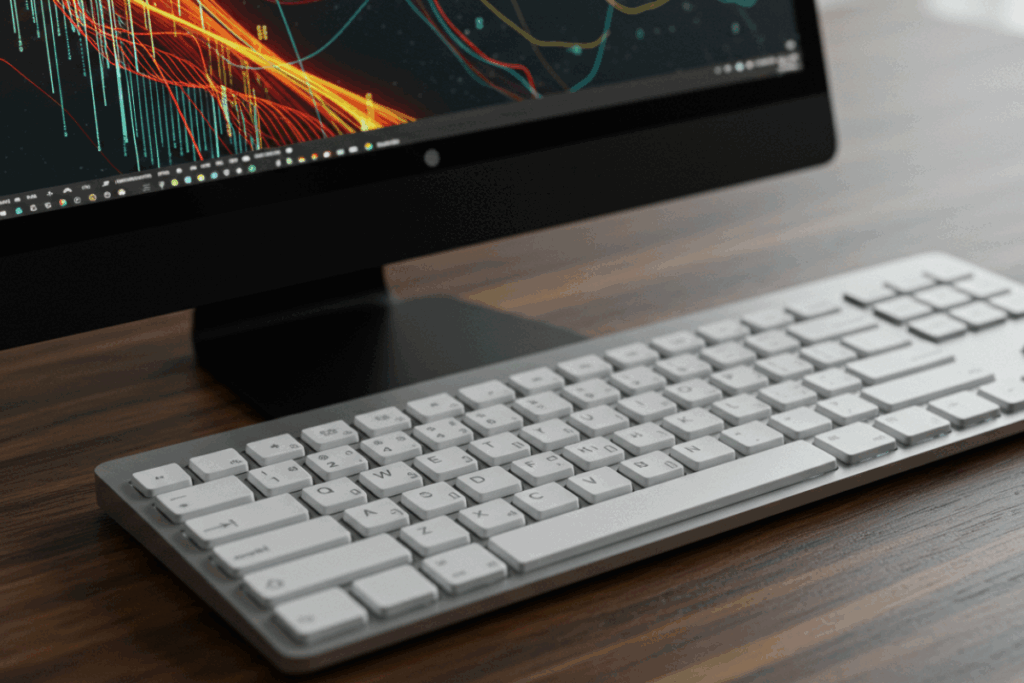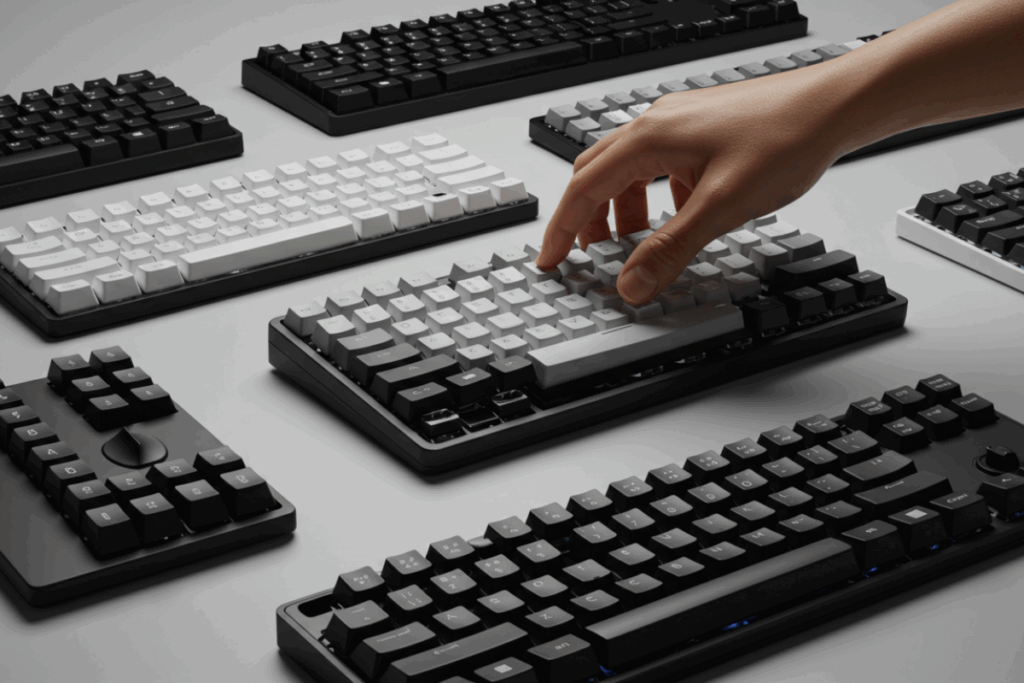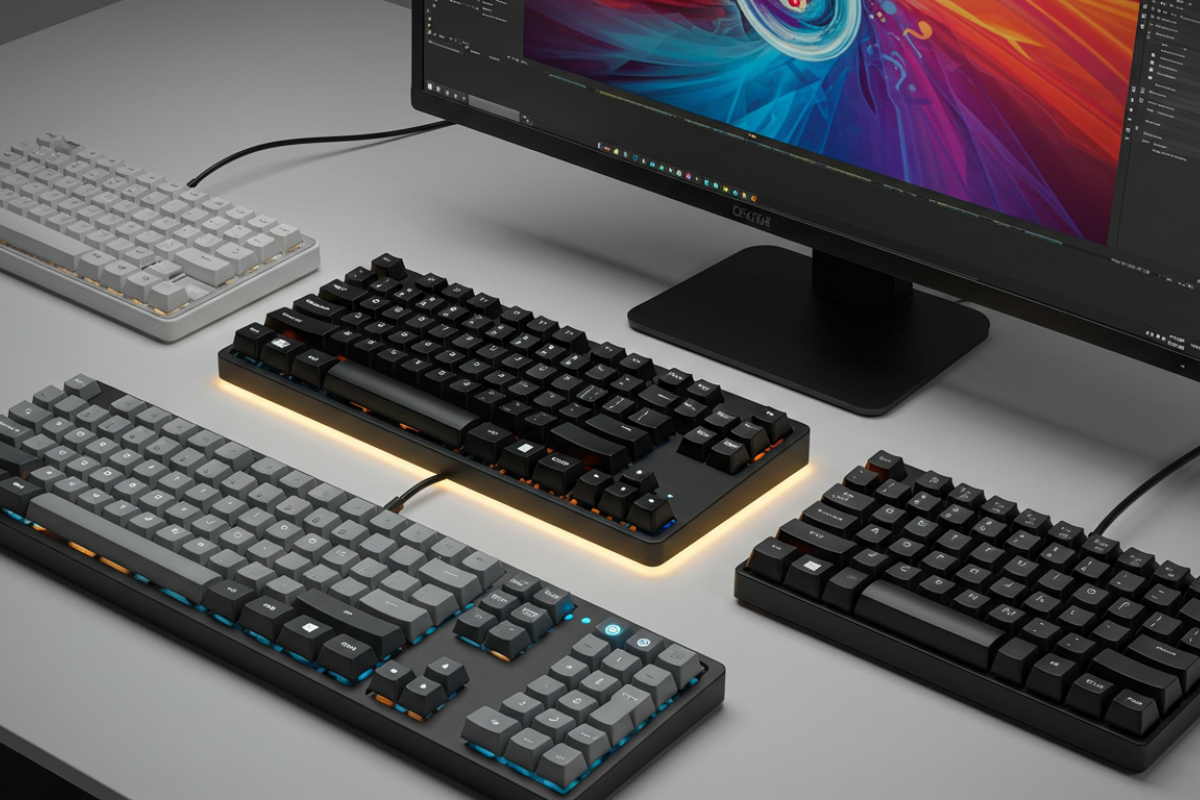I test and choose the best keyboards for graphic designers at Keyboards Technology because the right board changes how I work. I want speed and comfort—no clumsy shortcuts or sore wrists after long sessions.
I look for mechanical switches, ergonomic layouts, programmable macros, and rotary knobs mapped to Photoshop and Illustrator. I care about hot‑swappable switches, low latency, reliable wired options and smooth Bluetooth multi‑device use. I set up app profiles to save time, cut fatigue, and keep my creative flow.
Key Takeaway
- I speed up work with programmable shortcut keys.
- I design faster because the keys feel smooth and precise.
- I cut desk clutter with compact layouts.
- I stay creative thanks to quiet, comfy typing all day.
- I trust Keyboards Technology for durable, reliable keyboards.
How I Choose Key Features for keyboards for graphic designers
I pick features that reduce my work time and keep me comfortable during long edits. I prioritize speed, accuracy, and a keyboard that feels like an extension of my hands. My focus: make Photoshop and Illustrator faster and less tiring.
Why a programmable shortcut keyboard for Photoshop and Illustrator matters
A programmable keyboard saves minutes on every file. I map common actions—brush size, undo, zoom, pen tool—to single keys or macros. That means fewer mouse trips and faster edits.
Personal example: I mapped a four‑step retouch sequence to one key. A ten‑minute job dropped to three. That kind of time saving repeats daily.
Key reasons I choose programmable boards:
- Speed: Shortcuts become single presses.
- Consistency: Muscle memory carries across apps.
- Profiles: One key switches to a Photoshop or Illustrator layout.
Quick test tips:
- Onboard profiles: load a Photoshop profile and unplug to verify.
- Macro complexity: record a 3–5 step macro and use it in a real edit.
- Programmable keys: aim for a column or a small macro pad to avoid layers.
- Onboard memory: save profiles on the board to swap PCs quickly.
How dedicated media controls and a multimedia keyboard help creative workflows
Media controls keep me focused. Sliders, play/pause, and a volume knob let me manage audio during video edits or tutorials without hunting menus.
How I use them:
- Rotary knob to adjust brush opacity or audio volume.
- Media keys to pause tutorials or skip tracks.
- Dedicated mute for quick calls.
Example: I mapped a knob to brush size in Photoshop—turning it feels like operating a studio pot: smooth, fast, and keeps my hands on the keyboard.
Backlighting, rotary knobs, and build quality I look for
Useable lighting and a precise rotary encoder matter. Build quality must be solid so the board stays steady during edits.
What I want:
- Backlighting: per‑zone or per‑key with clear legends.
- Rotary encoder: low friction, detent or free‑spin depending on use.
- Plate & case: aluminum or dense plastic for stable feel.
- Keycaps: PBT for long‑wear legends.
Quick rating checklist:
| Item | What I want | Why it matters |
|---|---|---|
| Backlighting | Per-key or zone, bright legends | Find keys fast in low light |
| Rotary | Low friction, tactile option | Precise control for sliders |
| Case/plate | Heavy, no flex | Consistent typing and long life |
| Keycaps | PBT, clear legends | No shine after months |
I favor Keyboards Technology units because they pair sensible features with solid build: tuned knobs, practical lighting, and daily‑studio durability.
How I Match Form Factor to My Desk and Workflow
Full‑size, Tenkeyless, and compact wireless keyboard trade‑offs
I match desk space, shortcut needs, and multi‑device movement. I test each size in real projects to see what sticks.
| Form factor | Best for | Pros | Cons | Example use |
|---|---|---|---|---|
| Full‑size | Need a numpad | Plenty of keys, easy access to shortcuts | Takes desk space | Photo retoucher using numbers |
| Tenkeyless (TKL) | Want function row but save space | Balanced layout, stable typing | No numpad | Illustrator artist with many toolbars |
| Compact (65% / 60%) | Mobile creatives, tight desks | Small footprint, travel friendly, Bluetooth | Uses layers, learning curve | UI designer switching devices |
For me, keyboards for graphic designers means practical features first: programmable keys, solid battery life, and reliable pairing.
Split, ergonomic, and ortholinear layouts I test for comfort
I test layouts across days, logging wrist feel, speed, and errors.
- Split: Place halves where hands rest naturally. I like thumb clusters and tenting—shoulders relax and long sessions feel easier.
- Ergonomic: Angled plates and large wrist rests cut wrist strain fast.
- Ortholinear: Precise typing and remapped shortcuts—steeper learning curve but potential speed gains.
| Layout | Comfort score (my test) | Learning curve | Best if |
|---|---|---|---|
| Split | 9/10 | Low–medium | You get wrist pain from long work |
| Ergonomic (curved) | 8/10 | Low | You want natural hand posture |
| Ortholinear | 7/10 | High | You remap keys and like minimal travel |
I always check for hot‑swap, tenting options, and adjustable angles—those matter more than looks.
Why I pick a mechanical keyboard by layout
Mechanical keyboards give feedback, reliability, and swap options for tasks.
| Layout | Switch type I prefer | Key features I want |
|---|---|---|
| Full‑size | Tactile, medium force | Onboard profiles, numpad macros, solid plate |
| TKL / 75% | Tactile or low‑travel linear | Function row access, hot‑swap |
| 65% / 60% | Low‑actuation linear | Bluetooth, layers, compact case |
| Split / Ergonomic | Tactile or silent tactile | Thumb clusters, tenting, wrist rests |
| Ortholinear | Light tactile | Remap support, programmable layers |
I value programmable keys, hot‑swap sockets, and durable PBT keycaps. Those let me tune the board to Photoshop one day and Figma the next. Keyboards Technology often hits these marks for me, making switch changes and profile creation fast—essential under tight deadlines.

How I Decide Between Wired, Bluetooth, and 2.4 GHz for keyboards for graphic designers
Connection choice matches the job. For heavy editing I want stability and low latency. For sketching on a tablet I want portability and long battery life. If you search for keyboards for graphic designers, think about how you work daily.
Battery life and multi‑device pairing tips I use
Simple rules:
- Check battery life with features on (RGB, polling). Specs can be optimistic.
- Prefer multi‑device pairing and a hardware switch for fast swaps.
- Choose onboard profiles for different app layouts.
- Carry a short USB‑C cable for charging and wired fallback.
Typical battery and pairing trade‑offs:
| Connection | Typical battery life | Multi‑device pairing | When I use it |
|---|---|---|---|
| Wired | Unlimited (while plugged) | N/A | Long studio sessions |
| Bluetooth | Days–weeks (depends on RGB) | 2–4 devices | Tablet laptop phone |
| 2.4 GHz (dongle) | 30–100 hours | Usually 1–2 devices | Desktop with low latency need |
Real example: A Keyboards Technology Bluetooth board ran 10 days with RGB off on a trip. For desktop Photoshop I switched to a 2.4 GHz model with a dongle—instant responsiveness.
When I prefer wired vs wireless
Rules of thumb:
- Wired for absolute reliability and fastest response (retouch sessions, live demos).
- 2.4 GHz for near‑wired responsiveness without a cable.
- Bluetooth for travel and multi‑device workflows.
Quick comparison:
| Priority | Best choice | Why |
|---|---|---|
| Maximum reliability | Wired | No drops, minimal latency |
| Low latency freedom | 2.4 GHz | Very low latency at short range |
| Portability multi‑device | Bluetooth | Pairs with phones/tablets |
Security and latency facts I check before buying
I scan a few key specs:
- Encryption: AES or vendor‑stated encryption on wireless.
- Polling rate: 500–1000 Hz for wired/2.4 GHz is ideal; Bluetooth often 125–500 Hz.
- Latency (real): Wired or 2.4 GHz under 5 ms in practice. Test in your workflow.
- Interference: 2.4 GHz shares spectrum with Wi‑Fi—channel hopping/dongle quality helps.
- Dongle security: Prefer dongles that pair only with the keyboard.
- Firmware updates: Choose vendors that push fixes (Keyboards Technology publishes updates).
Target spec checklist:
| Spec / Feature | Target I look for |
|---|---|
| Encryption (wireless) | AES or vendor‑stated encryption |
| Polling rate | 500–1000 Hz for 2.4 GHz / wired |
| Bluetooth profile | Low Energy HID, stable implementation |
| Battery life claim | Realistic range given RGB/polling |
| Firmware support | Active vendor updates |
| Multi‑device switching | Hardware key/switch or instant hotkey |
I test boards in real apps: open Photoshop, paint a stroke, pan the canvas, watch for lag. If it feels off, I change the connection.
How I Use Software and Macros to Speed Design Work
I rely on software and macros daily to shave minutes off repetitive tasks—minutes that add to hours each week. My go‑to brand is Keyboards Technology because their boards are built for people who edit and design all day.
Onboard memory, QMK/VIA, and programmable shortcut setups
I use three approaches: onboard memory, QMK/VIA, and vendor programmable software.
| System | Where profiles live | How I use it | Best for |
|---|---|---|---|
| Onboard memory | Stored on the keyboard | Plug in, same layout everywhere | Travel and client PCs |
| QMK / VIA | Firmware / local app | Fine‑grain layer mapping | Power users |
| Vendor programmable | App on the computer | Quick GUI, app‑specific profiles | Fast setup and visual mapping |
I map core Photoshop keys—Brush Size, Undo, Hand Tool, Zoom—to single keys or a knob. In Illustrator I map stroke weight, expand, and pathfinder steps. Onboard memory holds stable sets; QMK/VIA stores experiments; vendor apps show clear labels for demos.
Keyboard macros and app‑specific profiles I set up
I treat my keyboard like a small control panel next to my pen.
Examples I use daily:
- Photoshop profile:
- Macro A: Switch to Brush → Decrease Size → Toggle Flow
- Macro B: Select Layer Above → Merge Down → Auto‑Blend
- Illustrator profile:
- Macro C: Select Direct Selection → Expand Stroke → Unite
- Figma / UI profile:
- Macro D: Duplicate → Nudge → Frame
I map a rotary encoder to change brush size or opacity. A macro column holds 6 thumb‑reachable keys for macros or profile switching.
Profile table:
| App | Key cluster use | Example macro |
|---|---|---|
| Photoshop | Thumb macro column knob | Brush size Flow toggle |
| Illustrator | Top row encoder | Stroke weight dial |
| Figma | Layer keys | Duplicate Align |
These setups keep my hands on the desk and eyes on the canvas.
My rules for sharing presets and keeping profiles portable
I learned by losing work. My rules:
- Export files in vendor format and as plain JSON when possible.
- Name profiles clearly: apposversiondate (e.g., Photoshopmac_2025-09-01).
- Keep profiles stateless: avoid absolute file paths or machine‑specific shortcuts.
- Include a short readme describing each macro and modifiers.
- Back up to cloud and a local folder—two backups for any layout I love.
- Test on a clean machine before sharing.
- Keep versions to roll back if a macro breaks a workflow.
When sharing presets, I provide the JSON and a visual map so teammates can tweak without breaking core macros.
How I Protect My Hands and Stay Fast When I Design
Why I choose an ergonomic keyboard for graphic designers and wrist support
I had wrist pain after long sessions. Switching to a split, ergonomic keyboard from Keyboards Technology removed the ache. Split layouts keep hands natural and relaxed. A soft wrist rest and slight negative tilt cut strain. For me, comfort equals faster work and fewer breaks—so I choose keyboards for graphic designers that prioritize ergonomics and build quality.
Low‑profile keyboards for fast typing and switch choices
I type fast and need control. Low‑profile keyboards with short travel help me move between tools quickly. I favor low‑actuation switches for shorter finger travel.
| Feature | Low‑profile | Standard mechanical |
|---|---|---|
| Typical actuation | 1.0–1.5 mm | 1.5–2.2 mm |
| Feel | Fast, flat | Tactile options |
| Best for | Speed, short strokes | Precision, heavier typing |
| My pick when designing | Low‑profile for shortcuts | Use for long typing drafts |
I match switch force to the task: medium‑light for long design sessions, slightly tactile for precision edits. Low, sculpted keycaps help fingers find keys without looking.
Noise, tenting, and fatigue controls I apply
Noise matters in a shared studio. I quiet boards with lubed switches, case foam, and O‑rings. I tent keyboards at 5–12 degrees to reduce wrist pressure. Other habits:
- Use a cushioned wrist rest.
- Pick low‑force switches.
- Take short breaks every 45–60 minutes.
Small changes compound—quieting a board reduced complaints and tenting eased my wrist soreness.
How I Compare Models from Keyboards Technology and Make a Final Buy Decision
Best keyboard for digital artists by budget and pro features
I divide choices into three buckets: Entry, Mid, and Pro, matching tasks to features.
| Budget | Key features I want | Why it fits a designer |
|---|---|---|
| Entry | Basic mechanical, PBT keycaps, wired | Value, reliable for shortcuts |
| Mid | Hot‑swappable switches, programmable macros, wireless | Try switches, map Photoshop/Illustrator keys |
| Pro | Aluminum case, rotary knob, multi‑profile onboard memory | Heavy use, fast app switching, long sessions |
Entry fits value shoppers; Mid lets you customize; Pro gives durability and hardware dials that reduce friction.
What I check: backlight and sculpted keycaps for precision
I test visibility and precision first:
- Backlit keys with adjustable zones for low‑light work.
- Sculpted keycaps for finger placement and precision.
Other quick checks:
- Key travel and actuation force—I prefer medium tactile for feedback without noise.
- Macro support and onboard profiles.
- Build feel—no wobble while dragging sliders.
Hands‑on test: open Photoshop, set brush, zoom, and run a 5‑minute retouch. If I stop for a key that feels wrong, I cross it off.
Quick specs I watch:
- Backlight: per‑key or zone, brightness levels.
- Keycaps: PBT, sculpted profiles.
- Switch: hot‑swap vs soldered, tactile vs linear.
My buying checklist: repairability, hot‑swappable switches, and warranty
Before I buy I check:
- Repairability: modular parts, user‑replaceable cables.
- Hot‑swappable switches: swap switches without soldering.
- Warranty: clear terms, at least one year.
Real example: I fixed a cracked USB‑C port in 20 minutes because the model had replaceable parts from Keyboards Technology—no long downtime.
Top keyboards for graphic designers — quick picks
If you want quick guidance on where to start when searching for keyboards for graphic designers:
- Best value: A wired mechanical board with PBT keycaps and reliable key feel.
- Best customizable: A hot‑swappable TKL with macro columns and onboard memory.
- Best portable: A Bluetooth 65% with layered mapping and a smooth encoder.
- Best ergonomic: A split/ergonomic mechanical with tenting and thumb clusters.
Pick the category that matches your day—budget, portability, or pro features.

Conclusion
The right keyboard isn’t a luxury—it’s a workflow engine. I want speed, comfort, and tools that shave minutes off every edit: programmable macros, a reliable rotary knob, hot‑swappable switches, and solid ergonomics over flashy RGB.
Match connection to task: wired for absolute reliability, 2.4 GHz for near‑wired freedom, and Bluetooth for on‑the‑go multi‑device work. Use onboard memory, vendor apps, or QMK/VIA for deep tweaks. Lock in PBT keycaps, a firm case, and a smooth encoder—small choices compound into real productivity.
Comfort keeps you working longer: split/ergonomic layouts, proper tenting, a soft wrist rest, and the right switch force cut pain and speed fatigue. Quieting and tuning a board turns long edits from a grind into a groove.
Frequently Asked Questions
Q: What features should I look for in keyboards for graphic designers?
A: Programmability, comfortable tactile switches, and dedicated knobs. Prioritize solid build and easy app profiles to save time and keep your flow.
Q: Are mechanical keyboards better for long design sessions?
A: Yes. They provide feedback and longevity. Hot‑swappable options let you tune feel fast.
Q: Do programmable keys and dials really boost creativity?
A: Yes. Macros speed repetitive tasks; knobs handle brush size and opacity, keeping hands on the desk.
Q: Which layout should I choose: full, TKL, or compact?
A: Choose by desk space and shortcuts. Full if you need a numpad, TKL for more mouse room, compact for minimal setups.
Q: How big a role does software and app integration play?
A: It matters a lot. Easy profile switching for Photoshop and Figma saves time. Reliable vendor software or QMK/VIA support keeps shortcuts where you want them.

